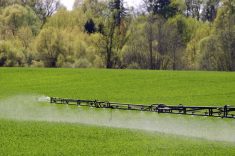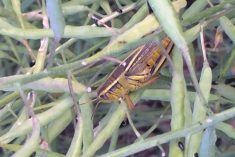Canadian farm use of the pesticide imidacloprid, from the controversial neonicotinoid family, is facing a three- to five-year phase-out from approval over its potential risks to aquatic insects.
Health Canada’s Pest Management Regulatory Agency (PMRA) on Wednesday announced it had completed a re-evaluation of the pesticide and has kicked off a 90-day public consultation period, from now until Feb. 21, on its proposed phase-out for the product.
For agricultural use, imidacloprid is marketed in Canada in seed treatments — such as Bayer’s Admire, Gaucho and Stress Shield and Adama’s Alias and Sombrero — and in other crop and greenhouse insecticides such as Bayer’s Concept, Intercept, Genesis and Merit and Cheminova’s Grapple. Off-farm, it’s also approved for use in various flea and lice treatments for dogs and cats.
Read Also

Senft to step down as CEO of Seeds Canada
Barry Senft, the founding CEO of the five-year-old Seeds Canada organization is stepping down as of January 2026.
PMRA’s assessment proposes the current use of imidacloprid “is not sustainable.” The product is being found in waterways and aquatic environments at levels harmful to aquatic insects such as mayflies and midges, which in turn are “important food sources for fish, birds and other animals,” the agency said.
Health Canada “is taking the findings of the re-evaluation of this pesticide seriously, and is taking action to further protect the environment,” Health Minister Jane Philpott said Wednesday in a release.
PMRA’s proposal calls for “any required changes to the use-pattern” for imidacloprid to take place within three years.
However, for uses where no “suitable alternative products” are yet available, a phase-out period of up to five years from the date of the PMRA’s final decision “may be considered.”
The phase-out would apply to all outdoor agricultural, ornamental, turf and tree uses (except tree injection uses) and greenhouse uses of imidacloprid.
Farmers and “other stakeholders” are to be consulted “to consider the availability of suitable alternatives,” the agency said.
The agency’s risk assessment found exposure to imidacloprid from spray drift and from runoff “may result in toxic effects to aquatic insects,” based on environmental modelling and Canadian water monitoring information. The product isn’t expected to pose a direct risk to fish, amphibians, algae or aquatic plants.
Environmental monitoring from “areas of intense agricultural activity” in Ontario and Quebec supported those findings, the agency said. Imidacloprid had been detected “frequently” in surface water at levels “well above concentrations that may result in toxic effects to insects.”
The regions in question included areas of both outdoor farm use, such as in potato and vegetable crops, and greenhouse use. The risks to freshwater insects couldn’t be attributed to a specific crop or application method, PMRA said.
The current continued use of the product isn’t sustainable, the agency said, because despite the precautionary label statements on all product labels to reduce the potential for runoff risk, and despite label restrictions against the release of imidacloprid from greenhouses into surface waters, the higher levels are still found in surface waters near areas where the product is in agricultural use.
“Robust” monitoring data isn’t available for all regions in Canada, the agency said, but “given the chemical properties of imidacloprid, it is anticipated that elevated levels may be found in many agricultural areas where there is a high volume of use.”
Thus, PMRA said, it can’t exclude any particular crop from its proposed risk management plan, “based on the available information.”
Also, the agency said, the available monitoring data “likely provide an underestimate of actual exposure, as sampling typically does not capture peak concentrations.”
Imidacloprid levels in surface water have been found to range from “non-detectable” up to as high as 11.9 parts per billion “in some rare cases,” Health Canada said. Evidence indicates levels above 0.041 parts per billion “are a concern.”
Other options that would see imidacloprid’s use curbed, but not eliminated, for the same risk-management result “would be difficult to achieve,” the agency said.
It would be tough to identify specific uses that caused elevated levels in water, PMRA said, because much of the water monitoring data came from “mixed-use” farming areas.
Also, the agency said, it’s “not possible to accurately predict how much use reduction would be necessary to achieve acceptable levels of imidacloprid in the environment and, therefore, any use-reduction strategy would require extensive and comprehensive water monitoring information to confirm that risk reduction targets are being achieved. It is also not possible to estimate how long a reduction in environmental levels would take.”
Also, in sectors where imidacloprid is “approved for use but not currently used extensively,” later intensified use “may lead to additional risks of concern.”
The agency acknowledged that for a few crops imidacloprid is the only approved insecticide for specific pests, and it has value as a seed treatment due to the “limited number” of registered seed treatments to manage the same pest and site combinations.
However, the agency noted, new insecticides have been submitted for approval and could serve as replacements in some cases, and label uses could possibly be expanded in other currently registered products.
That said, some of the alternatives “may have cost implications, be less effective against specific pests, or be under re-evaluation themselves,” PMRA said.
During the public comment period, and a planned “multi-stakeholder forum” expected to be held next month, PMRA said it would welcome any proposals for “potential alternative mitigation strategies that would achieve the same outcomes in a similar timeframe.”
However, the agency warned, any proposals that would allow imidacloprid’s continued registration would have to “clearly demonstrate concrete actions that would ensure that levels of imidacloprid in water would be reduced below the level of concern.”
The findings on imidacloprid have now also led the agency to launch “special reviews” for two other widely used neonicotinoids, clothianidin and thiamethoxam — looking specifically at the risks to aquatic invertebrates.
Both of the other neonics “are also being detected frequently in aquatic environments,” Health Canada said Wednesday.
The proposed phase-out for imidacloprid doesn’t relate to Health Canada’s still-ongoing evaluation of the neonic class of pesticides relating to the risk to bees and other pollinators.
Health Canada noted its re-evaluation efforts on the potential risks to pollinators have so far reduced the environmental risks of neonicotinoids.
For example, the department said, since it introduced mandatory “mitigation measures” on treated corn and soybean seed in 2014, the number of incidents reported at planting time has “decreased by up to 80 per cent.”
Ontario last year became the first jurisdiction in North America to limit use of seed treated with neonics. Quebec in 2015 announced plans for similar curbs. — AGCanada.com Network




















